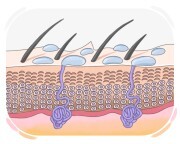a living thing such as a plant, animal, etc., especially a very small one that lives on its own

生物, 有机体
a substance that provides nutrients and conditions for the growth of cells or microorganisms

培养基, 生长介质
the process of growing cells, tissues, or organisms in an artificial environment with controlled conditions such as temperature, nutrients, and pH

培养, 细胞培养
relating to the chemical processes that occur within a living organism to maintain life

代谢的
a representative or characteristic sample that is examined or analyzed to gain insights or understanding of a particular group or category

标本, 样品
(biology) any of the groups that plants, animals, etc. with similar characteristics are divided into, which is larger than a species and smaller than a family

属, 种类
a genetic variant or subtype of a microorganism, typically within a species, that possesses distinct characteristics from other members of the same species

株, 变种
(of a cell, gland, or organ) to produce and release a liquid substance in the body

分泌, 产生
to discharge waste products or substances from the body or cells into the environment, typically through urine, feces, or sweat

排泄, 排出
a type of living thing with cells that have a nucleus and other structures enclosed in membranes, like plants, animals, fungi, and some microorganisms

真核生物, 真核生物体
a type of reproduction where a single organism can produce offspring without the involvement of another organism

无性繁殖
a type of cell division that creates reproductive cells with half the usual number of chromosomes

减数分裂, 染色体数目减半的细胞分裂
the longest phase of the cell cycle during which the cell grows, replicates its DNA, and carries out its normal functions

间期, 中间期
the initial phase of mitosis, where chromatin condenses into visible chromosomes and the nuclear membrane dissolves, preparing for cell division

前期, 有丝分裂的初始阶段
the stage of mitosis where chromosomes align along the center (equator) of the cell, preparing for their separation into daughter cells

中期, 中期阶段
the stage of cell division where sister chromatids or homologous chromosomes are pulled apart towards opposite poles of the cell by spindle fibers

后期, 分离期
the last stage of meiosis where chromosomes reach opposite poles, nuclear envelopes reform, and cells prepare to divide into daughter cells with half the original chromosome number

末期, 减数分裂的最后阶段
to break down or decompose naturally by biological processes, typically through the action of microorganisms like bacteria or fungi

生物降解, 自然分解
any molecule produced by living organisms including large molecules such as proteins, carbohydrates, lipids, and nucleic acids, as well as smaller molecules like vitamins, hormones, and metabolites

生物分子, 生物学的分子
the existence of a range of different plants and animals in a natural environment

生物多样性, 生物多樣性
a field of study that combines biology and computational methods to analyze and interpret biological data

生物信息学, 生物計算學
not causing harmful reactions or adverse effects when in contact with biological systems

生物相容性, 与生物系统接触时不会引起有害反应或不良影响
a branch of biology that employs statistical analysis to study and interpret biological phenomena and observations

生物统计学, 生物统计
the branch of biology that deals with microorganisms, including bacteria, viruses, fungi, and protozoa, and their effects on living organisms

微生物学
a scientist who studies the normal functions and activities of living organisms and their parts, often focusing on how biological systems work at the molecular, cellular, and organ levels

生理学家, 生理学专家
the scientific study of the environment or the interrelation of living creatures and the way they affect each other

生态学, 环境科学
tourism that includes visiting endangered natural environments which aims at preservation of the wildlife and the nature

生态旅游, 环保旅游
an approach to innovation and problem-solving that draws inspiration from nature's designs, processes, and systems

仿生学, 模仿自然
a thick slimy substance produced by mucous membranes, inside the nose or the mouth, to lubricate and protect them

粘液, 鼻涕
a complete virus particle that includes genetic material wrapped in a protein coat, capable of infecting host cells to replicate

病毒体, 完整的病毒颗粒
the process of training or adapting behavior through repeated experiences or stimuli to produce specific responses or associations

条件作用
a substance such as a vitamin, protein, fat, etc. that is essential for good health and growth

营养素, 营养物质
a special cell used for reproduction, with sperm cells being the male gametes and egg cells being the female gametes

配子, 生殖细胞
the collection of microorganisms, including bacteria, viruses, fungi, and other microbes, that inhabit a particular environment

微生物组, 微生物群
refering to processes, effects, or phenomena that are caused by human activity or influence

人为的, 人类活动引起的
the ability of an organism or cell to move independently using specialized structures such as flagella, cilia, or pseudopodia

运动性, 能动性
a single-celled organism that is neither a plant, animal, nor fungus, typically found in aquatic or moist environments

原生生物, 单细胞生物
reflecting a similarity in arrangement, type, or origin, particularly within the same species

同源的, 在结构或起源上相似
the light produced by by living organisms as a result of biochemical reactions, often used for communication, attracting prey, or camouflage

生物发光, 生物荧光
a small, plant-like aquatic organism belonging to the class Hydrozoa, often forming branching colonies

水螅体, 属于Hydrozoa纲的小型植物状水生生物
the process by which a differentiated cell changes its identity and adopts the characteristics of a different cell type

转分化, 细胞类型改变
the network of thread-like structures that form the vegetative part of a fungus, typically growing underground or within a substrate

菌丝体
(of an organism) engaging in a symbiotic relationship where both participants benefit from the interaction

互惠的, 共生的
describing a relationship between two organisms where one benefits and the other is neither helped nor harmed

共生的, 与共生有关的
a mutually beneficial symbiotic association between the roots of plants and fungi where the fungus colonizes the root system, facilitating nutrient uptake from the soil

菌根, 菌根共生
(of organisms) to absorb and incorporate nutrients or substances from their environment into their own tissues or cells

同化, 吸收
a reproductive cell capable of developing into a new organism without fusion with another cell, often adapted for survival in harsh conditions

孢子, 生殖细胞
the entirety of living organisms in a specific area or ecosystem, typically measured as dry weight after removing water

生物量, 生物质
the scientific discipline of classifying and naming organisms based on their evolutionary relationships and shared characteristics

分类学, 系统学
a shallow, circular, transparent dish with a lid, commonly used in laboratories to culture and study microorganisms

培养皿, 皮氏培养皿
a jelly-like substance extracted from algae, commonly used in biological culture media and as a thickening agent in foods

琼脂, 洋菜
extremely poisonous

有毒的, 剧毒的
the natural process where bacteria and fungi break down dead organic matter, returning nutrients to the ecosystem

分解, 腐烂
the underlying surface or material where an organism attaches, grows, or feeds

基质, 基底
capable of triggering an increase in the activity or responsiveness of the cell or organism

兴奋的, 刺激的
a single-celled organism used extensively in biological research as a model organism

裂殖酵母, schizosaccharomyces
a single-celled, microscopic organism belonging to the group of protozoa, characterized by a flexible cell membrane and the absence of a fixed body shape

阿米巴, 阿米巴
the process by which organisms evolve traits that improve their chances of survival and reproduction in a particular environment






